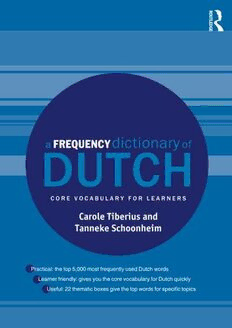
A Frequency Dictionary of Dutch: Core Vocabulary for Learners PDF
Preview A Frequency Dictionary of Dutch: Core Vocabulary for Learners
l A A , k dictionary v I a FREQUENCY of DUTCH 1 f 1 r CORE VOCABULARY FOR LEARNERS r r 1 r 1 Carole Tiberius and r 1 r 1 Tanneke Schoonheim r r Practical:thetop5.000mostfrequentlyusedDutchwords Learnerfriendly:givesyouthecorevocabularyforDutchquickly Useful:22thematicboxesgivethetopwordsforspecifictopics A Frequency Dictionary of Dutch AFrequency Dictionary of Dutch is a valuabletoolfor alllearnersof Dutch,providingalistofthe5,000mostfrequentlyusedwordsinthe language.Basedona290-million-wordcorpuswhichincludesboth writtenandspokenmaterialfromawiderangeofsources,this dictionarypresentsDutchcore vocabulary inadetailedandclearly arrangedmanner:eachofthe5,000entriesincludesEnglish equivalentsanda samplesentenceshowinglanguageinuse. Userscanaccessthetop5,000 wordsthrougheitherthemain frequency listingsoranalphabeticalindex.Throughoutthefrequency listingstherearethematicallyorganizedlistsfeaturingthetopwords fromavarietyof key topicssuchasanimals,foodandotherareasof daily andculturallife.WordsspecifictoDutchinBelgium(Belgian Dutch)arealsoincluded. Anengagingandefficient resource,AFrequency DictionaryofDutch willenable studentsofalllevelstogetthemostoutoftheirstudy. Thisbook wasprepared inassociationwiththeInstituut voor NederlandseLexicologie (INL,Institute ofDutchLexicology). A CDversionis availableto purchase separately.Designedforuse by corpus and computationallinguists,it providesthefulltextina formatthat researchers can process andturninto suitable listsfortheir ownresearchpurposes. CaroleTiberiusis a computationallinguist at theINL(Instituteof DutchLexicology). Tanneke Schoonheim isa linguist and lexicographer atthe INL (InstituteofDutchLexicology). Routledge Frequency Dictionaries GeneralEditors PaulRayson,LancasterUniversity, UK MarkDavies,BrighamYoungUniversity,USA EditorialBoard MichaelBarlow,University of Auckland,NewZealand GeoffreyLeech,Lancaster University,UK Barbara Lewandowska-Tomaszczyk,University ofLodz, Poland JosefSchmied,Chemnitz UniversityofTechnology, Germany AndrewWilson,Lancaster University, UK Adam Kilgarriff Lexicography Masterclass Ltd and University of Sussex,UK HongyingTao, UniversityofCaliforniaat LosAngeles ChrisTribble,King’sCollegeLondon, UK Other books inthe series A Frequency Dictionary of Arabic A Frequency Dictionary of Contemporary American English A Frequency Dictionary of Czech AFrequency Dictionary of French AFrequency Dictionary of German AFrequency Dictionary of Japanese AFrequency Dictionary of Mandarin Chinese AFrequency Dictionary of Portuguese AFrequency Dictionary of Russian AFrequency Dictionary of Spanish A Frequency Dictionary of Dutch Core vocabulary for learners Carole Tiberius and Tanneke Schoonheim * Routledge Taylor&tram\\Group LONDONANDNEWYORK Firstpublished2014 byRoutledge 2ParkSquare,MiltonPark,Abingdon,Oxon0X144RN andbyRoutledge 711ThirdAvenue,NewYork,NY10017 RoutledgeisanimprintoftheTaylor&FrancisGroup,aninformabusiness ©2014CaroleTiberiusandTannekeSchoonheimofINL TherightofCaroleTiberiusandTannekeSchoonheim,bothofINL,tobe identifiedasauthorsofthisworkhasbeenassertedbytheminaccordancewith sections77and78oftheCopyright,DesignsandPatentsAct1988. Allrightsreserved.Nopartofthisbookmaybereprintedorreproducedor utilisedinanyformorbyanyelectronic,mechanical,orothermeans,now knownorhereafterinvented,includingphotocopyingandrecording,orinany informationstorageorretrievalsystem,withoutpermissioninwritingfromthe publishers. Trademarknotice:Productorcorporatenamesmaybetrademarksorregistered trademarks,andareusedonlyforidentificationandexplanationwithoutintentto infringe. BritishLibraryCataloguinginPublicationData AcataloguerecordforthisbookisavailablefromtheBritishLibrary Library ofCongressCataloginginPublicationData Tiberius,Carole. AfrequencydictionaryofDutch:corevocabularyforlearners/CaroleTiberius andTannekeSchoonheim. pagescm. Includesbibliographicalreferencesandindex. 1. Englishlanguage-Dictionaries-Dutch. 2. Dutchlanguage-Dictionaries- English. 3. Dutchlanguage-SpokenDutch. I. Schoonheim, Tanneke. II. Title. PF640.T532014 439.313'21-dc23 2013024187 ISBN:978-0-415-52379-0(hbk) ISBN:978-0-415-52380-6(pbk) ISBN:978-1-315-85748-0(ebk) ISBN:978-0-415-82051-6(CD) Contents Thematic vocabularylists Seriespreface Acknowledgements Abbreviations Introduction Frequency index Core Fiction Newspapers Spoken Web General Alphabeticalindex Part-of-speechindex Thematic vocabulary lists 1 Animals 2 Body 3 Clothing 4 Colours 5 Emotions 6 Family andkinship 7 Foodanddrink 8 Materials 9 Nationalitiesandplace adjectives 10 Numbers 11 Professions 12 Sport 13 Time 14 Transportation 15 Weather 16 Opposites 17 ThevocabularyofDutchofBelgium 18 Personalpronouns 19 Possessivepronouns 20 Formsofthe verbzijn 21 Formsofthe verb hebben 22 Formsofthe verb worden Series preface Frequencyinformationhasacentralroletoplayinlearningalanguage. Nation(1990)showedthatthe4,000-5,000mostfrequent words accountforupto95%of a writtentextandthe1,000mostfrequent wordsaccountfor85%of speech.AlthoughNation’sresultswereonly forEnglish,theydoprovideclearevidencethat,whenemploying frequency asa generalguideforvocabularylearning,itispossibleto acquirealexiconwhichwillservealearner wellmostofthetime.There aretwocaveatstobearinmindhere.First,countingwordsisnotas straightforwardasit mightseem.Gardner(2007)highlightsthe problemsthatmultiplewordmeanings,thepresenceofmultiword items,andgroupingwordsintofamiliesorlemmas,haveoncounting andanalysingwords. Second,frequencydatacontainedinfrequency dictionariesshouldneveractastheonly information sourcetoguidea learner.Frequency informationisnonetheless a verygoodstarting point,andonewhichmay producerapid benefits.Itthereforeseems rationalto prioritize learningthewordsthat youarelikely tohear and readmostoften.That isthephilosophy behindthis seriesof dictionaries. Listsof words andtheir frequencieshavelongbeenavailable for teachersand learnersof language. For example,Thorndike (1921, 1932) andThorndike andLorge(1944)produced word-frequency bookswith countsof wordoccurrencesintextsusedintheeducationof Americanchildren.MichaelWest’sGeneral ServiceList of English Words(1953)wasprimarily aimed atforeignlearnersof English.More recently,withthe aidofefficient computersoftware andverylarge bodiesoflanguagedata(calledcorpora),researchershavebeenable toprovidemore sophisticatedfrequencycountsfrombothwrittentext andtranscribedspeech.Oneimportantfeatureoftheresulting frequenciespresentedinthisseriesisthattheyarederivedfrom recently collectedlanguagedata.TheearlierlistsforEnglishincluded samplesfrom,forexample,Austen’sPrideandPrejudiceandDefoe’s Robinson Crusoe,thustheycouldnolongerrepresentpresent-day languageinany sense. Frequency data derivedfrom a largerepresentative corpusof a languagebrings students closer tolanguage asit isused inreallife as opposedto textbook language(whichoftendistortsthefrequenciesof featuresinalanguage,seeLjung,1990).The informationinthese dictionariesispresented ina numberof formatsto allowusersto accessthedataindifferent ways. So,for example,if youwould prefer not to simplydrilldown throughthe wordfrequency list,but would ratherfocusonverbs for example,the partofspeechindex will allow youtofocusonjustthemostfrequentverbs.Giventhatverbstypically accountfor20%ofallwordsinalanguage,thismaybea good strategy.Also,afocusonfunction wordsmaybeequally rewarding- 60%of speechinEnglishiscomposedof a mere50functionwords. Theseriesalsoprovidesinformationofusetothelanguageteacher. Theideathatfrequency informationmay have aroletoplayinsyllabus designisnotnew(see,forexample,SinclairandRenouf1988). However,todateithasbeendifficultforthoseteachinglanguages otherthanEnglishtousefrequencyinformationinsyllabusdesign becauseofalackofdata. Frequency informationshouldnotbestudiedtotheexclusionofother contextualandsituationalknowledgeaboutlanguageuseandwemay evendoubtthevalidityoffrequencyinformationderivedfromlarge corpora.ItisinterestingtonotethatAlderson(2007)foundthatcorpus frequenciesmay not matcha native speaker’sintuitionabout estimates of wordfrequency andthat a setof estimatesof wordfrequencies collectedfromlanguageexperts varied widely.Thus corpus-derived frequenciesare stillthebest currentestimateof a word’simportance that alearnerwillcome across. Aroundthetimeof theconstructionof the first machine-readable corpora,Halliday (1971:344)statedthat ‘a roughindicationof frequenciesisoften just what isneeded’.Our aimin this seriesistoprovide as accurate aspossibleestimatesof word frequencies. PaulRayson andMarkDavies LancasterandProvo,2008 References Alderson,J.C.(2008).‘JudgingthefrequencyofEnglishwords.’Applied - Linguistics,28(3):383 409. Gardner,D.(2007).‘ValidatingtheconstructofWordinappliedcorpus-based vocabularyresearch:acriticalsurvey.’AppliedLinguistics,28:241-265.
